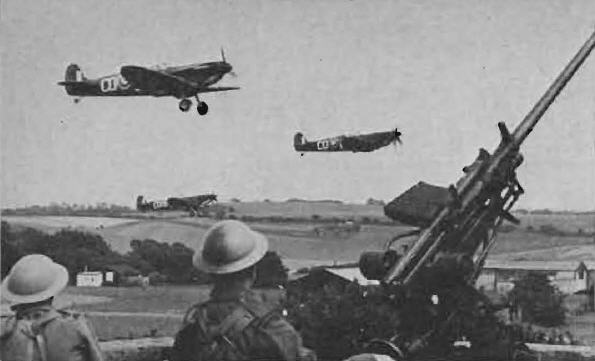
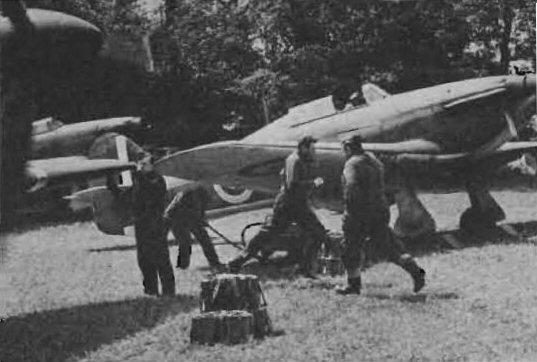
LEFT : Spitfires scramble from Hawkinge to intercept raiders over the Channel. RIGHT: Airmen race get their Hurricanes into the air at an R.A.F. base in France - actually the south side of Duxford (Photos are from the film unless stated otherwise)
THE BATTLE OF BRITAIN
article from Air Pictorial Magazine, September 1969
Battle of Britain-the Film
by J. D. R. Rawlings


LEFT :
Spitfires scramble from Hawkinge to intercept raiders over the Channel. RIGHT: Airmen race get their Hurricanes into the air at an
R.A.F. base in France - actually the south side of Duxford (Photos are from the
film unless stated otherwise)
ON THE 15TH of this month, Battle of Britain Day, cinemas in London, Glasgow, Edinburgh, Newcastle, Leeds, Manchester, Liverpool, Sheffield, Nottingham, Birmingham, Cardiff and Belfast will simultaneously be screening one of the most notable films ever made. Entitled simply "The Battle of Britain", it sets out to portray as accurately as possible what it was like to be in South-East England in the summer of 1940-and especially what was involved in being part of the outnumbered force of Fighter Command engaged in holding back the Luftwaffe, until then unchecked.
The film itself has had a somewhat hesitant career and almost foundered at one point through lack of finance but, thanks to help from the American film industry, it has now come through to completion as a Harry Saltzman production, with co-producer S. Benjamin Fisz - himself a wartime member of No. 303 (Polish) Squadron - and director Guy Hamilton. Before filming could take place a vast amount of research and preparation had to be done. First of all, some order had to be made out of the many differing accounts of the Battle that have appeared in print, some of them written by people with a particular axe to grind. So it was to the more authoritative sources that the film-makers turned for assistance, finding in the Derek Wood and Derek Dempster book The Narrow Margin (a new revised and improved edition of this book, with over 200 illustrations, has just been published by Arrow at 255) the most objective appraisal of the Battle, and looking to the Ministry of Defence (R.A.F.) for detailed help. Not a few of the actual participants of the Battle have been called upon to assure historical accuracy. On the German side General Adolf Galland was approached and he recommended Lt.-Col. Hans H. Brustellin, who became on-the spot consultant; for the R.A.F.'s part, Battle of Britain pilots Bob Stanford-Tuck and Ginger Lacey have had the tasks of technical advisers.
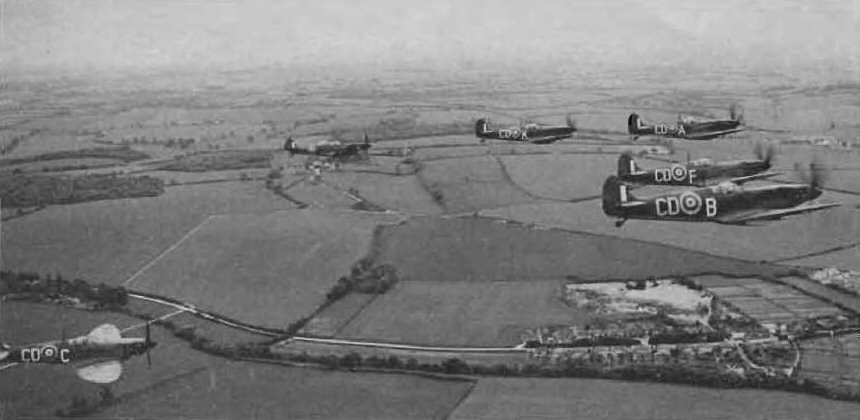
A formation of six Spitfires-two Mk. XIXs, three IXs and a
two-seat IX (uncoded) - starts the long climb to meet the raiders R.A.F.
base in France - actually the south side of Duxford
No single hero
The film deliberately sets out to provide no single hero and to cloak with anonymity the squadrons and personnel taking part as it i.> felt that, although there were, obviously, dominant characters in the Battle, what counted was the team work, from the humblest to the highest; this in a sense becomes the theme of the film. Sir Laurence Olivier takes the extremely difficult role of Air Chief Marshal Sir Hugh Dowding, Commander-in-Chief, Fighter Command at the time, whose withdrawn manner earned him the nickname "Stuffy" and whose real mastery of the Battle did not become fully apparent until the dust had settled. His "Number Two", Air Vice Marshal Sir Keith Park who commanded the key Group, No. 11 Group covering South-East England, in 1940 is portrayed by Trevor Howard. Sir Ralph Richardson and Sir Michael Redgrave take high-ranking parts in the Diplomatic Corps and the R.A.F. respectively. Robert Shaw, Michael Caine and Christopher Plummer play fighter squadron commanders, with Susannah York playing the wife of one of them, herself caught up in the Battle as a W.A.A.F. officer.
But no film about the Battle of Britain can stay on the ground and this presented the film-makers with one of the biggest headaches: where, in the late 1960s, could hordes of Hurricanes, Spitfires, Heinkels and Messerschmitts be found? This side of the production was put in the hands of Group Captain Hamish Mahaddie and his company, Spitfire Productions Ltd. Beginning four years ago his systematic searching brought surprising results-for instance, a world-wide count revealed the existence of 160 Spitfires with 109 in the U.K. alone. Most of these were of late marks such as the 16 and 19, which served with the R.A.F. after the war, and many were found as "gate guardians" at R.A.F. Stations. However, as aircraft began to be assembled at Henlow it was found possible to produce twelve flyable Spitfires, one of which was a Mk. II, P7350, which had been built in 1940 and served with Nos. 266, 603, 616 and 64 Squadrons; this aircraft had not flown for nineteen years but was restored to airworthy condition and was one of the most realistic of the flying Spitfires. Hurricanes were harder to find but Mahaddie eventually acquired six, of which three were flyable. Pinewood Studios then set to work to "build up" Fighter Command by constructing plastic Hurricanes and Spitfires - extraordinarily realistic ones-for use in ground shots, close-ups and as "dressing".
But, what was to be done about the Luftwaffe aircraft? The Air Historical Branch possessed single examples of the Junkers Ju 87, Ju 88, Heinkel He 111,
Messerschmitt Bf 109G, but none of these was flyable. Two Proctors were converted to an approximation of the J u 87 to provide flying Stukas but in the event these were not used. Mahaddie found his answer in Spain. The Spanish Air Force (Ejercito del Aire) had in store an appreciable quantity of Hispano HA-1112s, basically Messerschmitt Bf 109s with Merlin engines, and its bomber arm still used C.A.S.A. 2-111s, which are Heinkel He 111s with Merlins. This Service was most co-operative in allowing its aircraft to be resprayed and used for filming, and in selling twenty-eight HA-1112s and two C.A.S.A. 2-111s to Mahaddie. In addition, the Ejercito del Aire used Ju 52/3m's as transports and two of these were available for filming.This combined "air force" - claimed to be the 35th largest in the world - then needed manning. This presented no problem for the Spanish Air Force allowed many of its pilots to fly the Messerschmitts and Heinkels, and Spitfire Productions were inundated with requests from pilots wanting to fly the Hurricanes and Spitfires. Members of the colourful Confederate Air Force in Texas - a group of American pilots who have built up a living museum of World War II combat aircraft, and are thus in current flying practice with W.W.II types of aircraft - joined the ranks of suitably qualified British pilots for the job.

Messerschmitt 109s (actually Spanish Merlin-engined
Hispano HA-1112-MILs) head towards England;
note accurate camouflage and
disposition of formation
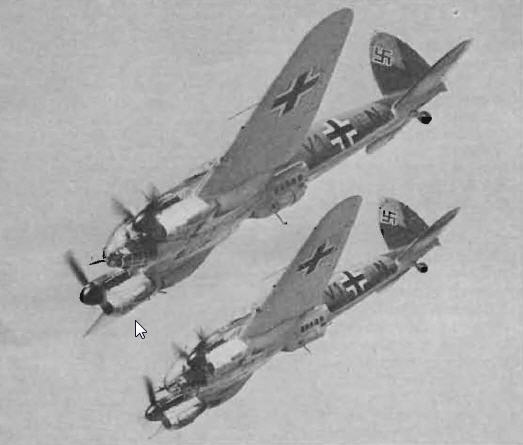
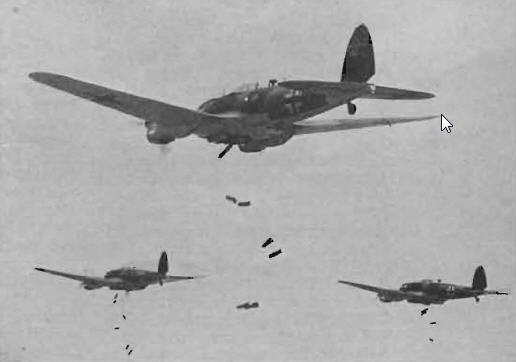
Spanish A.F. C.A.S.A. 2-111s, looking for all the world like 1940 Heinkel
He Ills (except for their Merlin engines),
during sequences of the bombing of
London; the aerial side of this episode was filmed in Spain
Filming in Spain
By now it was 1968 and at last the shooting could begin. First location was at Tablada in Spain where filming of the German sequences began in March last year. Because of the large fleet of He Ills most of the German formation and bombing scenes were flown there, the odd R.A.F. aircraft being flown out to "attack" the formations . The fleet of German invasion barges was re-created in Spain and filmed, and many of the German briefing and ground action sequences were also dealt with there. Coming back to England, Mahaddie brought two Heinkels and eighteen Messerschmitts, the latter modified with square wing tips and strutted tailplanes to approach as nearly as possible the Bf 109E version used in the Battle of Britain.
As the film is in colour, great pains were taken to ensure that the aircraft were in authentic paint schemes; the results are as near perfect as it is possible to get, both Luftwaffe and R.A.F. To increase flexibility of numbers, many of the aircraft were repainted several times with different markings to represent different units. With the Hurricanes and Spitfires great pains were taken to use code letter groups not representative of any particular squadron, the Hurricanes carrying "MI" and "KV" codes and the Spitfires "AI", "BO", "CD", "DO" and "EI". They also had fictitious serials: Hurricanes in the H34XX range and Spitfires in the N33XX range. As is well known, the leller "H" was never used as a serial prefix and the N33XX Spitfires use gaps in a Defiant production block. Also the letters "C" and "I" were not used in code letter combinations at the time of the Battle of Britain. This anonymity is only broken when the Hurricanes appear with Polish insignia, but as only one Polish unit, No. 303 Squadron, served in the Battle, the Hurricanes might just as well have carried 303's code, "RF".
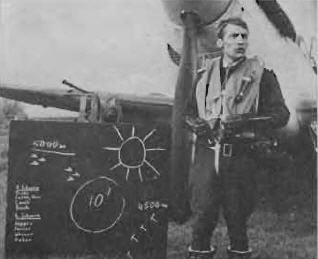
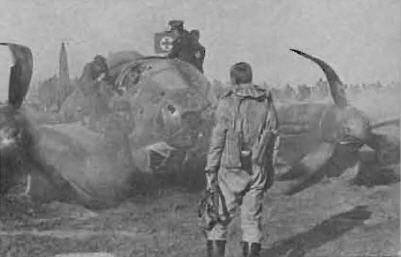
LEFT : Major Falke (Manfred Reddematm) briefs his pilots in front of a
Hispano/Messerschmitt 109. RIGHT : A German pilot watches attempts to get
his gunner out of his realistically crashed Heinkel He 111
In the U.K. five location scenes were used, four of them Battle of Britain airfields. The fifth was Dragon Road, off the Old Kent Road, where scenes of the actual bombing of London were created - very realistically according to local onlookers who had lived through it. Most of the filming was done at Duxford, which still had authentic hangars, one of which, by permission of the Ministry of Defence, was blown up during the filming of an attack on the airfield.
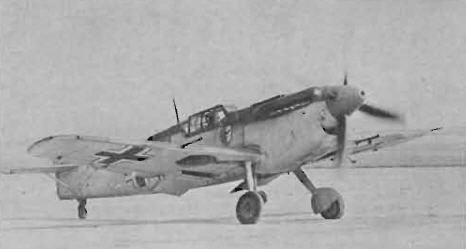
One of the Hispano HA -1112 -MILs with squared wing tips
and strutted tailplane taxi-ing in at Duxford after being
flown by
Confederate A.F. pilot Col. Connie Edwards.
Eighteen of these aircraft were brought to Britain (Photo:
George W. Pennick)
To provide historical context, the film begins with the RA.F. being driven out of France and a French airfield was built amongst the trees on the south side of Duxford, complete with a chateau background; many of the plastic aircraft were used here. Other locations were Hawkinge, where the bombed-out wartime hangars were rebuilt as background, North Weald and Northolt, while the dogfights were flown over the Kent coast and three areas of East Anglian and East Midland airspace which were allocated for the Battle. Even so, the odd Canberra, letting down into Bassingbourn, got the shock of its life on being intercepted by Messerschmitts and Spitfires.
To film all these flying sequences came Jeff Hawke and his North American Mitchell, N6578D, specially fitted out for aerial photography, with cameras in the nose and tail and using gun ports for other mounts. Known as the "Flying Platform" it is painted in a psychedelic pattern for two reasons: to show up well to the aircraft being photographed; and because patterns painted on its upper wings act as sighting lines for aircraft formating on it. Jeff Hawke specialises in this type of photography and, with his co-pilot, Duane Egli, flies all the photo sorties.
Now the film is complete and all is ready to show the world as nearly as possible what July, August and September 1940 were like in and below the skies of South-East England, when the RA.F.'s "Finest Hour" came as they rolled back the Luftwaffe's hordes and contained the voracious appetite of the German war machine. United Artists are responsible for the distribution.
AIRCRAFT USED IN THE FILM
At Tablada, Spain
C.A.S.A. 2·111 (Merlin-engined He 111): With the cooperation of the
Spanish Air Force twenty-nine of these aircraft were loaned for filming
purposes, together with crews for flying.
Junkers Ju 52/3m: Two loaned (or filming by the Spanish A.F.• one repainted
in D.L.H. markings and the other in Luftwaffe markings.
HA-1112-MIL (Merlin-engined, Hispano-built Messerschmitt Bf 109):
Twenty-eight (including one HA-1112-M4L) were withdrawn from Spanish A.F.
storage and sold to Spitfire Productions, eighteen of which were flyable and six
able to taxi.
Vickers-Supermarine Spitfire: Only one Spitfire, G-AVDJ, a Mk. IX,
was flown out to Spain and used in the filming sequences there.
In Britain
Most of the flying in the U.K. has been from Duxford, although some sequences have been flown from Manston (for the Channel fighting shots), others from North Weald, Northolt, Debden and Hawkinge; at the latter large replica hangars were built on the site of those already destroyed in the Battle.
C.A.S.A. 2-111: Two of those used in Spain were bought by Spitfire Productions and flown to this country. They carried various markings during the filming, their numbers being B2-177 (at one time "6J +PR") and B2-137 (also at one time "6J+PR"). Other unit codes carried by them were "AS" and "VI".
HA-1112-MIL: The eighteen flyable aircraft were brought to Britain and used for the flying sequences. Here again they received more than one paint job and were identified by numbers inside the flaps and wheel wells. Aircraft used included C~K-31. C~K-61. C~K-75, C~K-99 (at one time coded "7"), C~K-IOO (at one time painted with R.A.F. roundels and coded "MI:V"), C~K-I02. C~K-I05, C~K-I06 (at one time with chevron and bar), C"K-112 (at one time coded ;0 II "-this aircraft was the HA-1112-M"'L two-seater), C~K-122 (at ane time R.A.F. markings, coded "MI:T"), C~K-126 (at one time coded "9"). C~K-127 (at one time R.A.F. markings. coded "MI:S"), C~K-130 (at one time with chevron), C... K-I ...... (at one time coded "3"). C~K-152, C~K-169 and C~K-170 (at one time with chevron and bar).
Hawker Hurricane: Six were used, of which three were flyable; in addition, several full-size plastic replicas were made which were extremely realistic. Flyable aircraft were LF363 (painted H3...22 "H" on one side and H3HO "F" on the other), PZ865 (appearing as H3~2~ "MI:G" with Polish markings) and CF-SMI (which appeared both as H3HI "MI:O" and H3~18 "MI:A", also in Polish markings). Static aircraft were P2617. Z7015 and LF751.
Vickers-Supermarine Spitfire: No fewer than twenty seven Spitfires of varying marks were used, twelve flyable, six taxi-able and the rest static. Among the flyable aircraft were: P73S0, the Colerne Mk. II which had not flown for nineteen years but which was restored and flown spiritedly (at one time painted as N3321 "CO:M"): Mk. Vs AR501, G-AIST (painted as N3311 ("AI:B"). AB910; a Mk. I, AR213: Mk. IXs G-ASSO. G-AVOJ (ex OO-ARO), G-AVAV and G-AWGB. both ex-Irish T.9s (G-AVAV p.inted as "OO:H"); Mk. XIV, G-ALGT; and PR.XIXs PS835 and PS9IS. Static and taxi aircraft included: S718M (exBM587). a Mk. VB; SL57~, SM~II, TB382, TE31 I, TE356, TE38~. TEH6. RW382, .11 Mk. XVls; PM651, a PR.XIX; LAI98 and LAll6, both F.2Is; PK72~••n F.2~; MK356 and NH789. Mk. IXs; AB871 and EP120, Mk. VBs.
N.A. Mitchell: Camera ship was the converted Mitchell N65780.

Hurricane "dispersal" at Duxford. In the real Battle Hurricanes outnumbered
Spitfires by 3 to 2 (Photo: "Air Pic.")
* * *
BATTLE OF BRITAIN PICTURES
BATTLE OF BRITAIN Prints International Ltd. have acquired the exclusive licence from Spitfire Productions Ltd. to produce and sell colour prints and reproductions from the film "The Battle of Britain". The first set of eight prints, each 17 in. X 23 in., in full colour printed on thick art board, comprises pictures of a Spitfire, Hurricane, Messerschmitt 109 and Heinkel Ill, and montage prints of formation shots, dogfights, scenes from the film and actors, etc. Price is 75. 6d. per print, or 50s. for the set of eight which includes an illustrated sheet about the making of the film.
- END-
Back to Magazine Articles index page
Click here if navigation bar is not visible on the left